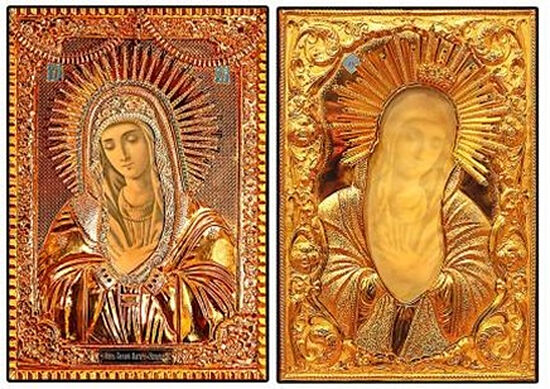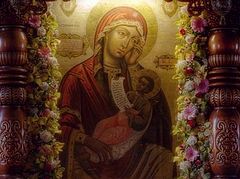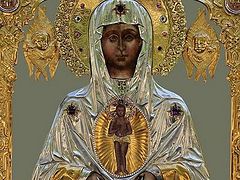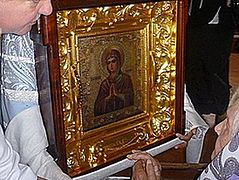Dozens of articles and a book were written about the wonderworking Lokot Icon, and videos were shown on TV.[1] This icon is so amazing that we deem it necessary to describe its history briefly.
Y. I. Shishkov, an assistant to Bishop Benjamim (196–2020) of Zheleznogorsk and Lgov of the Kursk Metropolia, says that he collected materials for the biography of Elder Melety (secular name: Matvey Ivanovich Demin (1880–1982)), who was a spiritual child of St. John of Kronstadt and spent the final years of his life in the village of Lokot of the Bryansk region. “Evgenia Fyodorovna and her daughter Natasha [a diminutive form of the name Natalia.—Trans.] would come to the elder to help him with housework.” The elder foretold to them: “Soon there will be a second sun in Lokta.” And he added that thousands of people would flock to Lokot from all over Russia and even from abroad. And he said to Natalia: “You will have to bear the cross. When that time comes, you will know.”[2]
Here is the story of the appearance of this icon, verbatim:
“Once in 1994, Natalia Nikolaevna in the Detsky Mir children’s department store noticed a wall calendar depicting the ‘Tenderness’ Icon of the Mother of God—St. Seraphim of Sarov’s favorite icon. The calendar was from the previous year, and she left the store frustrated. But her heart sank: the image looked so lonely in the store among the crowds of indifferent people, and no one was going to buy it. She returned and bought the two remaining calendars. At home she cut out the images and hung them on the wall.
“Once, during her illness in 1999, Natalia Nikolaevna was reading a book, on the cover of which was depicted the ‘Tenderness’ icon. Suddenly, much to her surprise, she felt a fragrance… It was coming from the icon cut from the old calendar. She and her husband decided to put the wonderworking image into a frame, and turning it over, they saw that the face of the Mother of God had appeared on the other side. They called a priest, sang an akathist, and the icon began to stream myrrh...
“Myrrh continues flowing to this day. The myrrh on the front side of the paper icon, covering it for so many years, contrary to the laws of physics does not soak through the paper. On the reverse side, a layer of oil only covers the image that became visible. Other miraculous events also take place through the prayers of Elder Melety and the mercy of the Most Holy Theotokos, Natalia Nikolaevna believes.”[3]
In 2019, in an interview with the Soyuz TV channel, Y. I. Shishkov spoke about the attitude of some spiritual Elders of our days towards the Lokot Icon:
“Father Nikolai (Guryanov; †2002): ‘This icon will be the wonder of all wonders in Russia.’ Archimandrite Kirill (Pavlov; †2017) blessed us to arrange All-Russian and international cross processions with this icon, which were organized with the support of the Rus’ Derzhavnaya Orthodox newspaper. Father Jonah (Ignatenko; †2014) of Odessa, when we were arranging the procession dedicated to the sixtieth anniversary of the victory in WWII, said, ‘I have been waiting for this procession for sixty years…’ When we reached Schema-Archimandrite Vlasy (Peregontsev; †2021) [father-confessor of St. Paphnutius of Borovsk Monastery near Kaluga.—Auth], he said about this icon, ‘This icon is a symbol of the Holy Canal of the Mother of God in Diveyevo. The more countries you will have time to visit with this icon, the more people it will have time to save.’ … And, of course, we rely on the opinion of the authoritative elder, Schema-Archimandrite Iliy (Nozdrin), the father-confessor of His Holiness the Patriarch, with whose blessing a book on this icon was written.”[4]
Let us add that “in 2003–2005, with the blessing of His Holiness Patriarch Alexei II of Moscow and All Russia, the editors of the Rus Derzhavnaya newspaper organized cross processions with the Lokot Icon of the Mother of God. Numerous articles about those processions and the icon itself were published in the newspaper.”[5]
Y. I. Shishkov said that the icon gained national fame in Russia in 2003 during the celebrations in honor of the 100th anniversary of the canonization of St. Seraphim of Sarov. First it was taken in a procession from the Kursk Diocese to Diveyevo, and then, with the blessing of Patriarch Alexei II, it was at the head of the procession with the relics from Sarov to Diveyevo.”[6]
“We do not know what kind of revelation he (Patriarch Alexei) had,” Y. I. Shishkov says. “For this historic procession he could have taken the original icon from Moscow (before which St. Seraphim of Sarov used to pray), or he could have taken the copy from Diveyevo, which is also regarded as wonderworking. But His Holiness chose a hitherto unknown lithograph, which was taken to Diveyevo with the Kursk cross procession…”[7]
Those who wish can find materials on the internet (in Russian) on numerous miracles and healings wrought by God through the intercessions of the Mother of God and prayers of the faithful in front of Her holy paper Lokot Icon. We cannot but recall the famous words here: “Where God wills, the order of nature is overruled; for He does whatsoever He wishes.”[8] The Lord violates not only the laws of nature, established by Himself, but also the philosophical schemes that try to limit the actions of His grace by some human rules that define “correct” and “wrong” icons.
Conclusion
The history of the Lokot Icon and other facts cited refute many, although not all, arguments of V.S. Kutkovoy and L.A. Uspensky.
1. According to Metropolitan Hilarion (Alfeyev), even postcards with reproductions of icons stream myrrh—although their veneration, according to V.S. Kutkovoy, is “philosophically problematic”. It seems that the problem can be solved in practice by every believer independently with a sense of personal piety and reverence, without immersion in philosophical reflections.
2. The Lokot Icon of the Mother of God, being a paper reproduction, is a holy object of the Church, as indicated by the following facts:
- The icon (in fact, a color photograph on paper of the “St. Seraphim—Diveyevo Tenderness” Icon) is called wonderworking on the official information resources of the Russian Church.
- With the blessing of the Church hierarchy the icon is carried around different dioceses for veneration by the faithful.
- The visits of the icon were coordinated by the Commission under the Patriarch of Moscow and All Russia on the Carrying of Relics.[9]
- With the blessing of the Church hierarchy, the icon takes part in cross processions.
- Numerous believers pray before the icon, including pilgrims who come specially.
- Through prayers in front of the icon the Lord performs miracles, which is what V.S. Kutkovoy asks for as a refutation of his opinion (“the action of the Holy Spirit through icons”).
3. With the blessing of the Primate of the Russian Orthodox Church, His Holiness Patriarch Kirill, as well as other bishops, an icon of the Mother of God (“Tenderness”) printed on paper has repeatedly in different dioceses been given and continues to be given veneration in Orthodox churches, including prayer services with the singing of the Akathist.
4. On the reverse side of the Lokot Icon, in addition to the image of the Mother of God, the Savior’s face from the Shroud of Turin appeared—the original image for all icons of the Savior, according to the Fathers of the VII Ecumenical Council and modern Sindologists and art historians. Obviously, this occurring in order to convince those who doubted the holiness of icons printed on paper and photo-reproductions.
5. The Russian Church knows several feasts for the “Tenderness” Icon of the Theotokos, including the “St. Seraphim—Diveyevo” one (July 28 according to the old calendar). There is still no feast of the Lokot “Tenderness” Icon in the Church calendar. Perhaps this is the only reason why our opponent V.S. Kutkovoy can remain with his opinion. However, this does not prevent believers from venerating this “paper icon” as holy and wonderworking instead of just honoring it “for moral reasons” as a reproduction in the calendar (as V.S. Kutkovoy insists[10]).
The phenomenon of the Lokot “Tenderness” Icon of the Mother of God and other wonderworking icons printed on paper refutes the opinion of experts who argue that only the originals painted by icon painters, and not their photo-reproductions, have the status of holy icons that must be venerated. In fact: The wind bloweth where it listeth (Jn. 3:8). And the sanctifying grace of God is communicated from the prototype to a person praying before a holy icon by Divine Providence, not according to the calculations of this or that icon painter, theologian or philosopher.
This author may hear objections (and indeed has heard objections): “Why then oppose the placing of reproductions of icons in calendars, on the covers of magazines and books, and in newspapers? Maybe someone could just cut out a reproduction, make an icon for himself and pray? And even if it does not stream myrrh, it will still help him in his sincere standing before God.”
The answer to objections like this is simple.
Firstly, there is no shortage of ready-made and affordable icons (at least in large cities). There is no such urgent need as in the Soviet era, when believers cut out reproductions from magazines and books in order to have at least a “paper icon” at home or even in church.[11] In addition, the current practice of making reproductions of holy icons anywhere (which we have already written about several times) is by no means specifically intended for making icons from them for home use. On the contrary, it is impossible to use many of them piously. For example, these are reproductions of icons on packing material, plastic bags and household items (bottle openers, key chains, etc.).
Secondly, let’s recall the circumstances of the discovery of the future wonderworking icon: The woman’s “heart sank” because two old calendars with the icon of the Most Holy Virgin would most likely lie around in the store for some time and then would be thrown away. And she not only saved these images from oblivion (“indifference”) and desecration, but also rendered due veneration to the “paper image” as a holy icon. After all, an image is truly holy due to the holiness of the hypostasis depicted—the Mother of God—regardless of the technological method of its creation and material. All subsequent events with this image are the inscrutable ways of Divine Providence.
Thirdly, how many cases do you know of when all (!) photo-reproductions of holy icons on any object (!) were treated as in the described case? Precisely all, because all photo-reproductions (and not only the chosen ones) deserve veneration in accordance with the doctrine on the veneration of icons and the theological foundations that were discussed in our first article. Unfortunately, in our everyday life most photo-reproductions of holy icons on objects not intended for prayer are, if not desecrated, then in scornful oblivion.
Let’s summarize.
All signs from “paper icons” (photo-reproductions) indicate that we should treat with great reverence any holy images, including illustrations that have become familiar and are often neglected by us in printing products and their reproduction on other objects.
And it is no coincidence that in the stories about the miraculous “paper icons” it is said that people prayed before them—that is, gave them due veneration as to holy icons. It is in response to these veneration and prayers that the Lord reveals His grace (the fulfillment of petitions, myrrh streaming, etc.).
But these same signs of God’s mercy call us to reasonable moderation and discretion in replicating holy images and to follow the teaching on the veneration of icons when choosing the material from which holy images are made and the objects on which they are placed at the will of the “technologist” (a publisher, a manufacturer of packaging and other “goods for the Orthodox”).
We repeatedly wrote earlier that the problem of regulating the circulation of holy images in a public non-liturgical space requires attention from the Church hierarchy and the adoption of a universal Church document.[12] While believers are waiting patiently for the introduction of such a regulatory document, we once again call on readers and all Orthodox to observe the rules of piety.
We updated these rules for modern conditions in the publication of the relevant recommendations, prepared together with Priest Alexei Knutov.[13] We encourage readers to familiarize themselves with them and apply these in their daily life.




